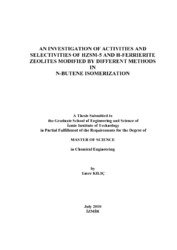Please use this identifier to cite or link to this item:
https://hdl.handle.net/11147/3054Full metadata record
| DC Field | Value | Language |
|---|---|---|
| dc.contributor.advisor | Yilmaz, Selahattin | - |
| dc.contributor.author | Kılıç, Emre | - |
| dc.date.accessioned | 2014-07-22T13:50:48Z | - |
| dc.date.available | 2014-07-22T13:50:48Z | - |
| dc.date.issued | 2010 | - |
| dc.identifier.uri | http://hdl.handle.net/11147/3054 | - |
| dc.description | Thesis (Master)--Izmir Institute of Technology, Chemical Engineering, Izmir, 2010 | en_US |
| dc.description | Includes bibliographical references (leaves: 103-106) | en_US |
| dc.description | Text in English; Abstract: Turkish and English | en_US |
| dc.description | xiii, 106 leaves | en_US |
| dc.description.abstract | In this study the synthesis and preparation of active and selective zeolite catalysts for the skeletal isomerization of 1-butene to iso-butene reaction were investigated. Since this reaction occurs on the acid sites, acidity of the catalyst plays important role on catalyst activity and isobutene selectivity. The acidity of synthesized HZSM-5, commercial Ferrierite (H-FER) and HZSM-5-C zeolite catalysts were modified by chemical liquid deposition (CLD) using tetraetyhyl orthosilicate (TEOS), SiCl4 and triaminopropyltriethoxysilane (3-amino), alkali, acid and ammoniumhexafluorosilicate treatment methods. Reaction tests were performed in a fixed bed reactor at 375 0C at weight hour space velocities of 22 h-1. SiCl4 deposition dramatically decreased the total acidity and surface area, both conversion and selectivity of the catalysts whereas TEOS increased selectivity. The highest selectivity (81.2 %) among CLD agents, were obtained by H-FER modified by TEOS 1 hour 1 cycle. Mild alkali treatment slightly decreased the acidity, which increased selectivity for H-ZSM5 from 57 to 60. However severe alkali treatment decreased the selectivity of the catalysts since some acid sites increased after this treatment. Acid treatment significantly decreased the surface area, acidity and caused dealumination. As a result catalyt activity decreased by 10 %. However, selectivity to isobutene changed slightly. Pre-alkali treatment before acid treatment decreased the dealumination effect, so this increased the selectivity; for H-ZSM5 from 57 to 66. AHFS treatment decreased the acidity slightly without affecting other properties. This increased the selectivity of H-ZSM5 from 58 to 87. The highest selectivity values were obtained for AHFS treatment among all modifications. | en_US |
| dc.language.iso | en | en_US |
| dc.publisher | Izmir Institute of Technology | en_US |
| dc.rights | info:eu-repo/semantics/openAccess | en_US |
| dc.subject.lcsh | Zeolites | en |
| dc.subject.lcsh | Ferrierite | en |
| dc.subject.lcsh | Zeolite catalysts | en |
| dc.title | An Investigation of Activities and Selectivities of Hzsm-5 and H-Ferrierite Zeolites Modified by Different Methods in N-Butene Isomerization | en_US |
| dc.type | Master Thesis | en_US |
| dc.institutionauthor | Kılıç, Emre | - |
| dc.department | Thesis (Master)--İzmir Institute of Technology, Chemical Engineering | en_US |
| dc.relation.publicationcategory | Tez | en_US |
| dc.identifier.wosquality | N/A | - |
| dc.identifier.scopusquality | N/A | - |
| item.openairecristype | http://purl.org/coar/resource_type/c_18cf | - |
| item.languageiso639-1 | en | - |
| item.openairetype | Master Thesis | - |
| item.grantfulltext | open | - |
| item.fulltext | With Fulltext | - |
| item.cerifentitytype | Publications | - |
| Appears in Collections: | Master Degree / Yüksek Lisans Tezleri | |
Files in This Item:
| File | Description | Size | Format | |
|---|---|---|---|---|
| T000193.pdf | MasterThesis | 44.81 MB | Adobe PDF |  View/Open |
CORE Recommender
Page view(s)
136
checked on Mar 31, 2025
Download(s)
82
checked on Mar 31, 2025
Google ScholarTM
Check
Items in GCRIS Repository are protected by copyright, with all rights reserved, unless otherwise indicated.